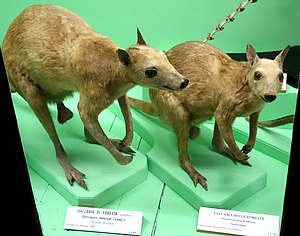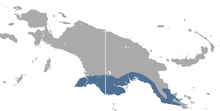Gray bush kangaroo
| Gray bush kangaroo | ||||||||||||
|---|---|---|---|---|---|---|---|---|---|---|---|---|

Prepared specimens of the gray bush kangaroo in the Natural History Museum of Genoa |
||||||||||||
| Systematics | ||||||||||||
|
||||||||||||
| Scientific name | ||||||||||||
| Dorcopsis luctuosa | ||||||||||||
| ( d'Albertis , 1874) |

The gray bush kangaroo ( Dorcopsis luctuosa ) is a species of the bush kangaroo group . It lives in the eastern lowlands of New Guinea and in the south around Merauke . The population on the southeastern peninsula is classified as the subspecies D. luctuosa luctuosa , while the subspecies D. luctuosa phyllis occurs between the Fly River and Merauke.
features
The gray bush kangaroo exhibits a large sex dimorphism in terms of size. Males reach a head-torso length of 72 to 97 cm and a weight of 6.7 to 11.6 kg. The females measured so far had a weight of about 3.6 kg. The fur is short and thin. The back is dark gray, the belly lighter, often with an orange tinge. The limbs are the same color as the body, but the hands and feet are darker. The head is dark, the throat is light. The tail is well haired and has a hairless tip that is sometimes lighter. The subspecies D. luctuosa phyllis is smaller than the nominate form, has a darker fur, shorter ears, shorter feet and a shorter tail. The sexual dimorphism is not so clearly pronounced in D. luctuosa phyllis .
Habitat and way of life
The gray bush kangaroo lives in primary and secondary lowland rainforests, in gallery forests and in human-influenced biotopes near the forest, such as overgrown gardens up to heights of 400 meters. Little is known about the way of life. It is crepuscular and becomes nocturnal when it is heavily hunted. They spend the heat of the day in a crouching position with their tail tucked forward through their legs. The gray bush kangaroo feeds on leaves, fruits and flowers. Specimens kept in captivity bit off their food with their incisors, then took them in their paws and used it to feed the food sideways into their mouths to chew them with their large premolars. Females have a single cub per year that remains in the pouch for a period of 6 months. Females become sexually mature at 15 months of age, males a little later.
Danger
The gray bush kangaroo is listed by the IUCN as low risk (Vulnerable). It is heavily hunted by humans, suffers from loss of habitat and has now disappeared in parts of its original range.
Individual evidence
- ↑ a b c d Mark Eldridge & Graeme Coulson: Family Macropodidae (Kangaroos and Wallabies). Page 694 in Don E. Wilson , Russell A. Mittermeier : Handbook of the Mammals of the World - Volume 5. Monotremes and Marsupials. Lynx Editions, 2015, ISBN 978-84-96553-99-6
- ↑ Dorcopsis luctuosa in the endangered Red List species the IUCN 2016 Posted by: Leary, T. Wright, D., Singadan, R., Seri, L. Allison, A., Aplin, K., James, R. , Flannery, T., Dickman, C. & Salas, L., 2015. Retrieved March 21, 2018.